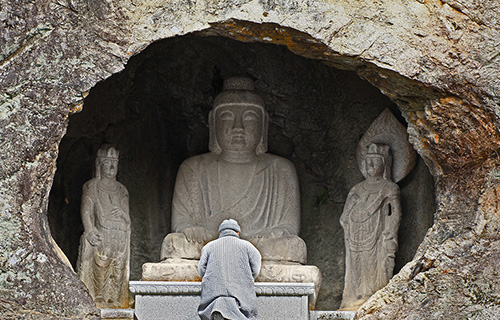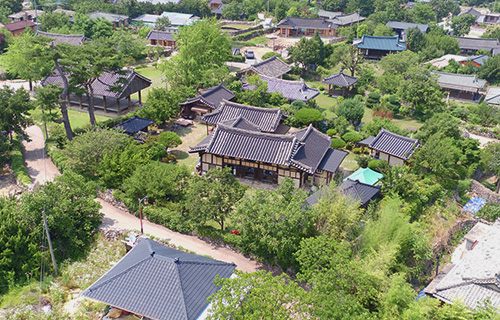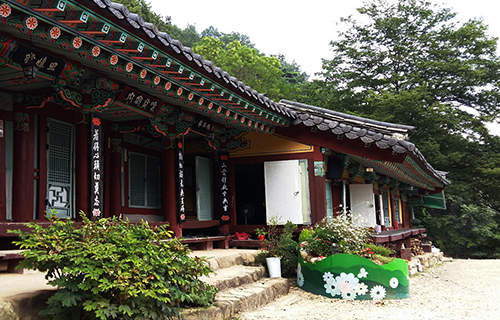
Birthplace of Cardinal Stephen Kim Sou-hwan
This park was built around Cardinal Kim Sou-hwan's birthplace to carry on his legacy of love and sharing. The park also celebrates Kim Sou-hwan’s achievements as a key figure in Korean Catholicism and as a spiritual pillar as Korea's first-ever Cardinal.
The Cardinal Kim Sou-hwan Memorial Hall located within the park is an immersive learning center where you can learn about the Cardinal's life and philosophy, and it also gives visitors a respite from their earthly worries and troubles.
- Address : 270, Gunwigeumseong-ro, Gunwi-eup, Gunwi-gun

Jibosa Temple
Jibosa Temple is believed to have been built by Uisang Daesa in the 13th year of King Munmu’s reign (673 CE). The temple was named Jibosa because it housed three treasures. The first treasure was a large cauldron, and the second was a natural five-colored clay, which is said to have been used as pigment for Dancheong decorations. The third treasure was a millstone. However, the three treasures were either plundered by the Japanese or lost during the Japanese colonial period, which did everything within their power to destroy and bury our culture and heritage.
The three-story stone pagoda inside the Temple was designated as Treasure No. 682, and the buildings within the Temple’s premises are called Daeungjeon, Samseongjeon, Yosachae, and Seobyeoldang halls.
- Address : 233, Sanggok-gil, Gunwi-eup, Gunwi-gun

Gunwi Hyanggyo
Built originally in the 1st year of King Seongjong's reign (1470 CE), Gunwi Hyanggyo was destroyed during the Japanese invasion of Korea in 1592 CE. In the 40th year of King Seonjo's reign (1607 CE), Ryu Seong-ryong (柳成龍), who was serving as the Yeonguijeong at the time, and Lee Oh-bong (李五峯), a local scholar, sent Seongji (聖智), a Buddhist monk who was well versed in the art of Feng Shui, to find a new site. Eventually, the Hyanggo was restored in Soeddong Valley (now Hagok-ri), at the southern foot of Seonbangsan Mountain. Today, however, the exact site is unknown. Gunwi Hyanggyo was moved back to its current location in the 27th year of King Sukjong's reign (1701 CE), and was fully renovated in 1973 CE.
The Hyanggyo features the Daeseongjeon, Myeongryundang, Gwangpungnu, Dongjae, Seojae, and Naesammun.
- Address : 233, 17-28, Dongseo 2-gil, Gunwi-eup, Gunwi-gun

Beopjusa Temple
Beopjusa Temple, located on a towering peak on the southeastern side of Cheonghwasan Mountain in the northwest of Dalsan-ri, Sobo-myeon, was built by Simji Wangsa in the 15th year of King Soji’s reign of Silla. Although the Temple was destroyed in the 1st year of King Injo’s reign of the Joseon Dynasty, it was rebuilt in the 1st year of King Hyeonjong taking the throne (1660 CE).
Beopjusa Temple is the last temple of Eunhaesa Temple in Yeongcheon-si. It features a five-story stone pagoda designated as Cultural Heritage Material No. 27 and the largest millstone in Korea (Folklore Heritage No. 112). The rock and grindstone are 115cm in diameter and 15.5cm thick, respectively. Recently, the large (over 23-ja 5-chi in length and over 15-ja in width) Hanging Painting of Beopjusa Temple was designated as Treasure No. 2005.
- Address : 215, Dalsan 3-gil, Sobo-myeon, Gunwi-gun

Grotto of Amitabha Buddha Triad in Gunwi
This grotto, built inside a natural cliff-side cave, is located at the northern foot of the Palgongsan Mountain range, on a cliff 20m above the ground. Inside the cave, the Amitabha Triad Stone Buddha, the main Buddha created around 700 CE, is enshrined in a cross-legged posture, and the two other Bodhisattva statues sit on either side of the main Buddha.
The style predates the Seokguram Grotto in Gyeongju by a century, and holds great significance in the history of Korean cave grottoes and temples.
- National Treasure No. 109
- Address : 303, Namsan-ri, Buge-myeon, Gunwi-gun

Hanbam Village
Daeyul-ri, Bugye-myeon, is a village where each house is surrounded by low-lying stone walls that give the entire community a friendly and approachable look. Even after hundreds of years, the 10-ri stone walls and old houses have been preserved intact, which is why the village is often called “little Jeju” on the mainland by tourists.
Around 950 CE, a scholar named Hong Ran, who is believed to be the progenitor of the Hong clan from Burim, settled here and named the village Daeya (大夜). Later, the village was renamed to Daeyul (大栗), which is why the village is also known as Hanbam village.
- Address : 2137-3, Hanti-ro, Bugye-myeon, Gunwi-gun

Uiheung Hyanggyo
An exemplary example of a traditional Hyanggyo in the Yeongnam region, Uiheung Hyanggyo was built in the 7th year of King Taejo's reign (1398 CE) of the Joseon Dynasty. It burned down during the Japanese invasion of Korea in 1597 CE but was rebuilt during the reign of King Seonjo. The Hyangyo then moved to its current location in Subuk-ri, Uiheung-myeon, during the reign of King Injo. Uiheung Hyanggo is the only place in the Province that enshrines its original memorial tablet and hosts a memorial service every fall.
- Address : 89-27, Eupnae-gil, Uiheung-myeon, Gunwi-gun

Sutaesa Temple
Sutaesa Temple is located on Seonam Mountain named so because of its shape that resembles a boat.
The Temple was founded by Uisang Daesa in the 1st year of King Munmu’s reign (661 CE) of Silla. Unfortunately, the original structure was lost, and the Temple that remains today was rebuilt later on.
It is said that Sutaesa Temple got its interesting name because the founder was hoping it could bring an abundance of water and alleviate the frequent droughts in the local area.
- Address : 202, Jiho 2-gil, Uiheung-myeon, Gunwi-gun

Hwabon Village and Hwabon Station
Hwabon Village, located in Sanseong-myeon, still retains the distinct look and feel of the early modern times in Korea. Hwabon Station and the official residence built during the Japanese colonial period, dolmens, steam locomotive water towers, a nostalgia-inducing coffee shop, and Yeokjeon Sanghoe store can take you on a trip down memory lane. There are murals inspired by Samguk Yusa painted on the walls around Hwabon Station, and the “When Mom and Dad Were Young” museum inside the old Sanseong Middle School building, is a popular destination as it gives people a chance to immerse themselves in an environment reminiscent of their own in their youth.
- Address : 711-9, Sanseonggaeum-ro, Sanseong-myeon, Gunwi-gun

Ingaksa Temple
Built by Uisang Daesa in the 11th year of Queen Seondeok’s reign (642 CE) of Silla, Ingaksa Temple was where Buddhist monk Il-yeon, a state preceptor during the Goryeo Dynasty, stayed with his mother in his later years and wrote Samguk Yusa, one of Korea's premier history books. The Temple is located in Hwabuk-ri, Samgukyusa-myeon, Gunwi-gun.
The Temple got its name, Ingaksa, since it was built where the horns of a giraffe, an imaginary animal to Korean people at the time, would be.
- Address : 250, Samgukyusa-ro, Samgukyusa-myeon, Gunwi-gun

Apgoksa Temple
In 677 CE (the 17th year of King Munmu’s reign of Silla), Uisang Daesa first built Apgoksa Temple 5km northwest of where today’s Temple is. When it became clear there was not enough room for the Temple, Uisang fashioned a wooden duck and threw it from a peak in Amisan Mountain, roughly 8km south of the original Temple.
The duck landed where today’s Temple is, and so Uisang rebuilt Apgoksa Temple in its current location.
- Address : 836-144, Hyeonri Nakjeon-gil, Samgukyusa-myeon, Gunwi-gun

Hwasan Sanseong Fortress
Hwasan Sanseong Fortress, located south of Hwasan Village, was built in the 35th year of King Sukjong's reign (1709 CE) in the Joseon Dynasty by Yun Suk, who was serving as the Byeongma Jeoldosa at the time, to protect the area from raiding Japnese pirates. Unfortunately, while building the 4-meter-high fortress wall stretching 200m from Heungyemun Gate to Sugumun Gate, a severe drought and crop failure disrupted construction. Works never resumed, which is why the Fortress remains unfinished to this very day.
- Address : San-230, Hwabuk-ri, Samgukyusa-myeon, Gunwi-gun
페이지 만족도조사
- 담당부서 :
- 전화번호 :
- 최종수정일 : 2023-09-11